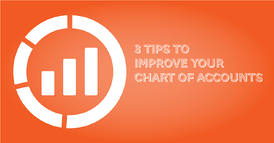 One questions that I often recieve from clients is what should I do to improve my chart of accounts? To answer that I have here 3 tips to improve your chart of accounts.
One questions that I often recieve from clients is what should I do to improve my chart of accounts? To answer that I have here 3 tips to improve your chart of accounts.
Chart of Accounts
The chart of accounts is a list of categories used to organize the transactions your business encounters in your accounting software. A good chart of accounts will include categories for all income and expenses, bank accounts, accounts receivable, inventory, accounts payable, cost of goods sold, and equity.
Depending on the type of entity your business is (S-Corp, C-Corp, Partnership, LLC, Non-Profit), there are specific chart of accounts that are used. The accounting software you use usually will have a generic list of accounts to help you create your ideal chart. For example, QuickBooks has preset chart of accounts depending on what industry you are in. Using the generic charts is a great place to start and can be modified to meet your specific needs. This will help produce reports that will assist you in making management decisions in your business.
1) Use Account Numbers
The first thing to do in improving your chart of accounts is to use account numbers. Now, this is not mandatory in most accounting software but it does help keep things organized. If you are not using account numbers, I would recommend you add it to your chart. By having account numbers assigned to each type of account, it makes it easy to follow and locate specific items. In general, you can use the below guide in grouping the accounts in your chart:
1000 series = Assets
2000 series = Liabilities
3000 series = Equity
4000 series = Income
5000 series = Cost of Goods Sold
6000 series = Operating Expenses
7000 series = Other Items
Now, the above is a just a guide. You can use 100 series or 10000 series, it doesn’t matter. What matters is the grouping of the account, meaning when you need an Expense account, you use the 6 series or when you need an Income account, you use the 4 series. Having account numbers in your chart is a great way to keep things structured.
2) Consistent Naming Convention
The second thing to do in improving your chart of accounts is to make sure a consistent naming convention is used across the board. For example, if you are creating a bank account, make sure it is a 1 series account (Asset account) and the naming convention is consistent for all bank accounts. If you have 2 bank accounts at Wells Fargo that need to be setup, one a Checking and the other a Savings, you can use the below format:
1000 = “WFB Checking #1234”
1001 = “WFB Savings #4567”
When you are naming your accounts, add as much detail as possible so when you look at the account description, there is no question of what it is. Some accounting software limit the number of characters in their naming convention, see what the limit are in your accounting software before creating an account.
Account Name Character Limits | |
|---|---|
| QuickBooks: | 31 (source) |
| Xero: | 150 (source) |
3) Maintain It
The third thing you can do to improve your chart of accounts is to maintain it frequently. Maintenance is key in an effective chart of accounts. If there are accounts that are no longer used or have never been used, make them inactive or delete them. There is no point of having extra accounts that are cluttering your chart. Also, review your chart to make sure all accounts are grouped correctly. If an account was created and classified incorrectly (e.g. Classified as an Expense account instead of Income account), make sure that is corrected immediately because it will affect your financial reports. Make it a habit to visit your chart of accounts at least twice a year if not more to make sure everything is intact and accurate. This will help you produce clean financial reports and we have discussed before how helpful financial report can be.
Having an effective chart of accounts will help you keep things organized, produce clean financial reports and make you and your CPA a lot happier when tax season comes along. The above 3 tips will help you do that.


